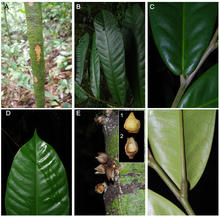In June 2016 I went to the Monts de Cristal National Park in Gabon (as part of the AFRODYN project), basically to the same area where Hervé Sauquet and myself discovered Sirdavidia solannona back in 2012. I was walking aorund trying to find more individuals and populations of Sirdavidia and checking to see if it was flowering (which it was not...). After a while my Gabonese colleague, Raoul Niangadouma, and myself fell upon a medium sized tree with small flowers at the base. The species looked like an Uvariopsis, but it was "weird" looking. The flower buds were sessil and incredibly the crushed flowers and leaves emitted a strong scent of lemon. The leaves were very large for the genus too. To date, there has been no repports of lemon scent in Uvariopsis, and only a single species has sessile flowers (U. sessiliflora), and this was not that! The only other lemon scented species I know of in African Annonaceae is also from Gabon, and is Uvariodendron molundense var. citrata (Le Thomas 1969, Flore du Gabon).
At that point we knew we had a new species of Uvariopsis. It was hard to think that yet again in this same area we stumbled upon yet another new species of Annonaceae (just 100 m from the type locality of Sirdavidia), even though we were quite close to Kinguélé village and the main road! No sooner did we get back to our camp did we started to write up the article (see photo below). The idea was to show that we should not wait too much before describing and publishing new names. In our case it took less than two months between collection of the type and publication in PhytoKeys. Sure, we didn't spend all day in different herbaria going through all the material available, however, I was sure it was new and there were no names associated with this species yet. Do you agree?
The new species is called Uvariopsis citrata Couvreur & Niangadouma. The area where we collected these new species deserves an increased protection and more botanists should wander around there given its easy access.
Link to the open access publication. We also pubished a new species of rattan, collected a few days later.


Me describing the new species in the field

Add new comment